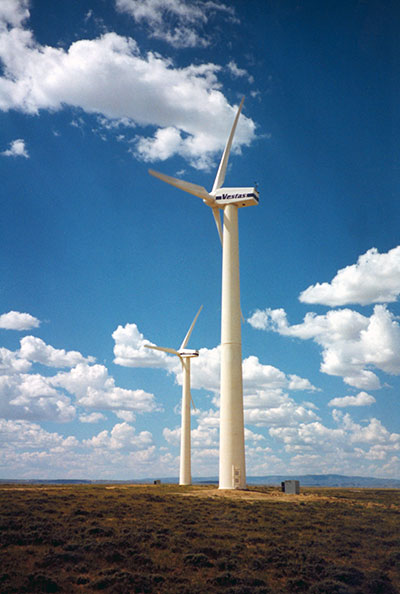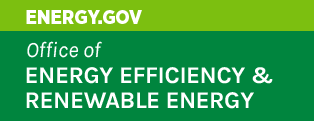Economics and Incentives for Wind
Wind energy projects provide many economic benefits, including direct and indirect employment, land lease payments, local tax revenue, and lower electricity rates–plus other financial incentives. Although these benefits depend on factors such as location, size, and ownership, the overall economic impacts of wind energy development are easy to see.
Wind energy projects create jobs and provide a revenue source for farmers and ranchers—which can be spent in the neighboring community. Learn more about wind energy’s economic impacts to communities.
An essential element of planning any energy development project is estimating and understanding project costs and benefits, while exploring location siting (including ordinances. WINDExchange provides information related to the economic impacts from wind energy development, including wind energy’s ability to offset energy costs, federal energy subsidies and other project financing incentives, policy effects on project economics, analysis tools to help interested parties assess projects, and the economic impacts to neighboring communities.
What Are the Costs to Develop Wind Energy?

Purchasing a wind turbine is one cost to developing a wind farm, along with other installation expenditubres, but there can be many fincancial benefits to wind energy development. Photo from Werner Slocum, National Renewable Energy Laboratory
A wind turbine typically pays for itself after a number of years, but it will have high upfront costs. The average cost of a wind energy project depends on the size of the project (e.g. how many square feet or square miles the project occupies and how many turbines the project uses), the size of the turbines used, and the project location. Average wind energy project costs typically fall into two categories: turbine cost and installed project cost. To then run the wind energy project requires ongoing operations and maintenance costs.
How Much Do Wind Turbines Cost?
Land-based wind turbine prices fell in 50% between 2008 and 2020, with a slight increase to about $850 to $950 per kilowatt in 2022.
How Much Is the Installed Project Cost?
Installed project costs include capital expenditures, meaning one-time costs related to designing, setting up, and installing a new asset (here, a wind farm or distributed wind system).
According to the latest market reports from the U.S. Department of Energy Wind Energy Technologies Office, capital expenditures for:
- Land-based wind energy was about $1,200 to $1,800 per kilowatt (kW), roughly equal to costs in the early 2000s after a 40% dip from a 2009 peak.
- Offshore wind energy was about $3,500/kW to $4,000/kW.
- Distributed wind energy was about $7,850/kW for small systems and $4,050/kW for those over 100 kW in size.
How Much Do Operations and Maintenance Cost?
Sites also require costs to operate a wind farm, including paying wind energy workers and land leases, and maintain it, including attending to safety, repowering equipment, and servicing any other issues. These costs can vary between projects, depending on factors such as size, location, age, and wind resources in the area.
In 2023, land-based wind farms cost operators, on average, >$40/kW annually. According to the International Energy Agency, in 2013, offshore wind farms costed 22.15 cents per kilowatt hour in operations and maintenance, compared with 8.66 cents per kilowatt hour for land-based wind farms. Costs are expected to decrease with increasing efforts to improve offshore wind energy technology and transmission.
The Windfarm Operations and Maintenance cost-Benefit Analysis Tool from National Renewable Energy Laboratory researchers allows owners and operators to estimate these costs and evaluate the benefit of a potential project.
What Is the Price of Wind Energy?
Researchers at the National Renewable Energy Laboratory reported that, in 2022, the cost of levelized energy (the average minimum price the power must be sold at to offset production costs in the technology’s lifetime) for:
- Land-based installations was $39 per megawatt-hour (MWh), with a range of landbased estimates from the single-variable sensitivity analysis covering $30–$57/MWh.
- Fixed-bottom offshore wind farms was $95/MWh, with a range of $52–$184/MWh.
- Floating offshore wind farms was $145/MWh, with a range of $52–$184/MWh.
- Small distributed wind system was $235/MWh and $163/MWh, for residential and commercial, respectively
- Large distributed wind energy was $78/MWh.
What Is A Power Purchase Agreement?
A power purchase agreement (PPA) is a legal contract between a buyer and a seller, typically a utility company and a renewable energy project developer, respectively. Under a PPA, the buyer agrees to purchase electricity generated by the renewable energy project over a specified period of time at a predetermined price and the seller commits to supplying the agreed-upon amount of electricity to the buyer. PPAs provide financial certainty for the project developer, enabling them to secure financing for the construction and operation of the renewable energy facility, while the buyer benefits from a long-term, fixed-price supply of clean energy.
In 2019, the national average price of wind power purchase agreements dropped to below 2 cents per kilowatt-hour, dropped to below 2 cents per kilowatt-hour, meaning that, including financial incentives like the Production Tax Credit, new wind energy facilities provided some of the cheapest available forms of new electricity generation available at that time.
Utility-scale wind power can also be sold at fixed prices for long periods (e.g., 20 years), providing a hedge against volatility in commodity fuels such as natural gas.
How Can Wind Energy Offset Power Use and Costs for Users?
An additional way that wind energy projects can make a positive economic contribution is by offsetting energy costs.
Distributed wind turbines can be used to directly offset customer electricity usage. A system of this type can be used for homes or farms, schools and other community buildings, and large business or industrial facilities using many megawatts of electrical energy. Generating your own electricity can also provide a hedge against possible rising retail electricity rates.
For example, in remote villages in Alaska, installing wind turbines are an effective offset to the costs of transporting fossil fuels into the community, while also helping their energy system become more sustainable, reliable, and independent.
This concept, called net metering, allows for a wind turbine to be installed close to a load and supply energy directly to that load, thus reducing the energy purchased by the consumer at retail rates. In some setups, power that is not used by the home can also be credited to the customer as it flows back on to the electricity system see DSIRE’s net metering page to learn more about policies.
How Can I Estimate the Economics of a Potential Wind Energy Project?
Projecting costs and benefits of new installations, including the economic development impacts, is a key element in evaluating potential wind projects. Visit our [Economic Impacts page] to learn more about the economic development potential wind energy projects offer communities.
Our Land-Based Wind Energy Economic Development Guide is a comprehensive resource for community decision makers (such as county commissioners, local decision makers, economic development corporations, businesses, landowners, and interested community members) about economic considerations regarding land-based, utility-scale wind energy. To help readers better understand the economic development potential during the development, construction, and operation of wind energy projects, the guide covers the following five topics: wind energy basics, local government revenue sources, community development information, landowner and development considerations, and the business and local workforce.
We also provide links to software applications and publications to help individuals, developers, local governments, and utilities make economic decisions about wind power.
What Are the Economic Impacts of Wind Farms to Neighboring Communities?
Wind energy projects attract jobs, increase tourism, and provide a revenue source for farmers and ranchers, which can be spent in the neighboring community. Nearby wind farm developers can also offer voluntary community benefits, which can be financial, to invest in local programs and businesses. Learn more about wind energy’s economic impacts to communities.
